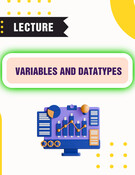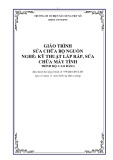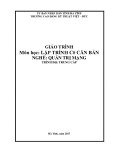
16
Chapter 16:
Making the System Operational
Systems Analysis and Design in a Changing
World, 3rd Edition
16
Systems Analysis and Design in a Changing World, 3rd Edition 2
Learning Objectives
Describe implementation and support activities
Choose an appropriate approach to program
development
Describe various types of software tests and
explain how and why each is used
16
Systems Analysis and Design in a Changing World, 3rd Edition 3
Learning Objectives (continued)
List various approaches to data conversion and
system installation and describe the advantages
and disadvantages of each
Describe different types of documentation and
the processes by which they are developed and
maintained
Describe training and user support requirements
for new and operational systems
16
Systems Analysis and Design in a Changing World, 3rd Edition 4
Overview
This chapter focuses on activities of
implementation and support phases of systems
development life cycle (SDLC)
Implementation activities occur before system is
turned over to users
Implementation consumes more time and
resources than earlier phases of the SDLC
Support activities occur after system becomes
operational and may continue for years
16
Systems Analysis and Design in a Changing World, 3rd Edition 5
Activities of the Implementation
and Support Phases
16
Systems Analysis and Design in a Changing World, 3rd Edition 6
Program Development
Program development is time consuming
One-third of development labor
One-third to one-half of project development
schedule
Programming and testing considerations:
Required resources
Managerial complexity
System quality

16
Systems Analysis and Design in a Changing World, 3rd Edition 7
Order of Implementation
Input, process, output (IPO) development order
Based on data flow through system
Simplifies testing
User interfaces developed early to reduce change
Disadvantage is late implementation of outputs
Structured design –IPO order based on system
flowchart and structure chart
OO design –IPO order in package diagrams
16
Systems Analysis and Design in a Changing World, 3rd Edition 8
Order of Implementation (continued)
Top-down and bottom-up order from traditional
structured design and structured programming
Top-down begins with top structure chart module
Always a working version of program
Requires three or more iterations to complete
Bottom-up begins with modules at lowest level of
structure chart
Many programmers can begin immediately
Requires driver programs to test
16
Systems Analysis and Design in a Changing World, 3rd Edition 9
System Flowchart for a Payroll System
16
Systems Analysis and Design in a Changing World, 3rd Edition 10
Structure Chart for a Payroll System
16
Systems Analysis and Design in a Changing World, 3rd Edition 11
Package Diagrams for RMO Subsystems
16
Systems Analysis and Design in a Changing World, 3rd Edition 12
Package Diagram for Three-Layer OO

16
Systems Analysis and Design in a Changing World, 3rd Edition 13
Construction and Test Plan
Development order
Testing order
Data used to test modules, module groups,
methods, classes, programs, and subsystems
Acceptance criteria
Relevant personnel assignments (construction
and testing)
16
Systems Analysis and Design in a Changing World, 3rd Edition 14
Framework Development
When developing large OO systems, object
frameworks or foundation classes are often
constructed
Foundation classes typically implemented first
Minimizes impact of errors and changes
Reused in many parts of the system and across
applications
Assigned to best programmers and thoroughly
tested
16
Systems Analysis and Design in a Changing World, 3rd Edition 15
Team-Based Program Development
Management Issues
Organization of programming teams
Task assignment to specific teams or members
Member and team communication and
coordination
Variety of different models used for organization
16
Systems Analysis and Design in a Changing World, 3rd Edition 16
Comparison and Summary of
Development Team Types
16
Systems Analysis and Design in a Changing World, 3rd Edition 17
Source Code Control
Source code control system (SCCS)
Automated tool for tracking source code files and
controlling changes to those files
Repository of code and programmer actions
Check out file in read-only mode
Check out file in read/write mode
Check in a modified file
16
Systems Analysis and Design in a Changing World, 3rd Edition 18
Versioning
Mechanism to manage systems changes
Complex systems developed, installed, and
maintained in series of versions to simplify testing
and support
Alpha Version –incomplete testing version
Beta Version –end user testing version
Production Release Version –formally distributed
to users or made operational
Maintenance Release –bug fixes, small changes

16
Systems Analysis and Design in a Changing World, 3rd Edition 19
Description of Versions for RMO
16
Systems Analysis and Design in a Changing World, 3rd Edition 20
Quality Assurance
Process of ensuring information system meets
minimum quality standards
Determined by users, implementation staff,
management
Identification of gaps or inconsistencies in
systems requirements
QA integrated into project throughout SDLC
Cost of fixing errors rise as project progresses
16
Systems Analysis and Design in a Changing World, 3rd Edition 21
Technical Reviews
Opens design and construction process to input
from other people
Other programmers can frequently see errors
missed by original programmer
Similar to author writing and editor reviewing
Walkthroughs and inspections
Reduce number of errors by factor of 5 to 10
Reduce testing costs by 50%
16
Systems Analysis and Design in a Changing World, 3rd Edition 22
Testing
Process of examining a product to determine if
any defects exist
Testing levels are related to specific SDLC
phases
Testing activities spread throughout SDLC
Most of testing takes place following software
construction and definition of defect standards
16
Systems Analysis and Design in a Changing World, 3rd Edition 23
Generic Model of Software Testing
16
Systems Analysis and Design in a Changing World, 3rd Edition 24
Correspondence Between SDLC Phases
and Various Types of Testing

16
Systems Analysis and Design in a Changing World, 3rd Edition 25
SDLC Phases and Testing Activities
Performed Within Each Phase
16
Systems Analysis and Design in a Changing World, 3rd Edition 26
Test Cases
Important part of testing is specifying test cases
and data
Test cases specify one or more events to which
software must respond
Starting state
Events to which software responds
Expected response or ending state
Analysis phase documentation is useful in
preparing test cases
16
Systems Analysis and Design in a Changing World, 3rd Edition 27
Unit Testing
Testing individual modules of code or methods
before integration with other software
Driver module used for testing
Sets values of input parameters
Calls module to be tested and passes input
parameters
Accepts return parameters from tested module
Stub testing –test module simulates module not
yet developed
16
Systems Analysis and Design in a Changing World, 3rd Edition 28
Integration Testing
Tests the behavior of a group of modules or
methods
Test both normal processing and exceptions
Errors can include:
Interface incompatibility
Incorrect parameter values
Run-time exceptions
Unexpected state interactions
16
Systems Analysis and Design in a Changing World, 3rd Edition 29
System Testing
Tests the behavior of the entire system
Build and smoke test is performed daily to
discover any problems with daily builds
Performance test checks time-based requirements
Acceptance test is performed to determine
whether system meets user requirements
16
Systems Analysis and Design in a Changing World, 3rd Edition 30
Data Conversion
Data needed at system startup
Files or databases of system being replaced
Manual records
Files or databases of other systems
User feedback during normal system operation
Reuse of existing databases
Reloading database contents
Creating new databases


























